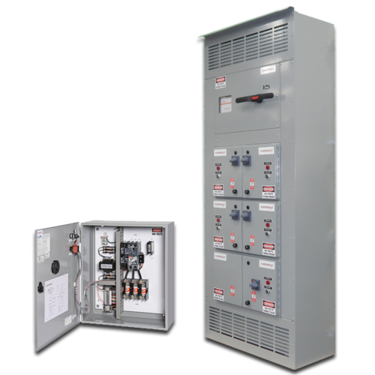Benefits
For use in fire safety and elevator control
Mersen’s Fusible Shunt Trip Switch is an all-in-one solution that meets many different code requirements with the protection and safety in elevator shafts. According to NFPA 13, 8.14.5, sprinkler protection is required at the top and bottom of elevator shafts. With that being said, NFPA 13 requires the installation of sprinklers in the elevator machine room. Once a sprinkler system has been introduced to either the elevator shaft or elevator machine room, you are now installing these per the State-Adopted Elevator Code ANSI/ASME A17.1.
To summarize ASME A17.1, Safety Code for Elevators and Escalators, Rule 102.2 (c) (3) requires the shutdown of power to the elevator prior to the application of water in the elevator machine room and or hoistway.
The shutdown of power is accomplished by a shunt trip device in the elevator circuit. This reduces the risk of any potential electrical shock once the water is released into the system. This will also reduce the risk of any elevator car slippage once the cables and hoist system become saturated from the release of water. In addition to turning off the power, 2002 NFPA 72 6.15.4.4 (Fire Alarm Code) requires:
“Control circuits to shut down elevator power shall be monitored for the presence of operating voltage. Loss of voltage to the control circuit for the disconnecting means shall cause a supervisory signal to be indicated at the control unit and required remote annunciation.”
This is achieved with the Fire Monitoring Relay (FR Relay), a standard feature in Mersen’s Fusible Shunt Trip Device. In the event of a power loss, at which point a back up power supply is introduced to the system, you are now required to meet NEC Article 620.91 paragraph (C) emergency or standby power system. This is accomplished with a set of mechanical interlock auxiliary contacts which comes standard as 1-N/O and 1-N/C contact. The auxiliary contacts prevent the elevator from descending down and injuring any workers that could be working in the elevator shaft. This also allows the elevator to move to the next convenient location and open the doors to let any passengers out in the event of an emergency.
- Shunt Trip Switch – Allows for tripping of the main line power via remote signal
- Fused Switch – Provides high current-limitation and short circuit withstand
- Padlockable Handle – Allows panel to be locked with switch in the off position ensuring load side power isolation during servicing
Applicable Codes and Standards:
- NFPA 13, 8.14.5
- NFPA 72 6.15.4.4
- ANSI/ASME A17.1
- NEC 620.91
- cUL US Listed
Capabilities
An array of available options allows for maximum functionality to be built into a single compact panel. Panels built for elevator applications feature control transformers (fusing both primary and secondary sides), a fire safety interface relay with a fire alarm voltage monitoring relay, and mechanically interlocked auxiliary contacts. Use of Mersen’s Amp-Trap 2000® AJT Class J fuses permits easy selective coordination, while providing the panel and its components with superior current limitation and the ability to withstand high fault conditions. AJT fuses provide added system reliability since no maintenance or periodic testing is required as with other electromechanical overcurrent devices.
Fusible Shunt Trip Switch
- Primary Voltage (208, 240, 480 or 600 VAC)
- Standard voltage monitoring relay.
- Fire safety relay for control interface (3PDT Relay, choice of Coil Voltage: 120 VAC, 24 VDC or 24VAC)
- Oil-tight key switch to test 2 position selector switch
- Oil-tight power enabled indicator light (choice of colors: red, green or white)
- Isolated neutral lug – 100%. Oversized 200% for excessive Non-Linear loads
- Multiple options for auxiliary contacts and alarm contacts for indication. Handle activated microswitch is available for operation under test conditions.
- NEMA 12, 3R, 4 or 4X enclosure available
- DC Shunt Trip Switch Version Available – Consult Factory
Multi-Unit Fusible Shunt Trip Switch Panel:
- Top or Bottom Feed, Main Fused Switch (400, 600A, or 800A) or Main Lug Only (MLO)
- Branch ratings of 30A, 60A, 100A, 200A, and 400A branch frame sizes available. Unit can accommodate up to (6) shunt trip switches of 200A or below, or up to (3) 400A units, or combinations thereof.
- Primary Voltage (208, 240, 480 or 600 VAC)
- Standard voltage monitoring relay.
- Fire safety relay for control interface (3PDT Relay, choice of Coil Voltage: 120 VAC, 24 VDC or 24VAC)
- Oil-tight key switch to test 2 position selector switch
- Oil-tight power enabled indicator light (choice of colors: red, green or white)
- Isolated neutral lug – 100%. Oversized 200% for excessive Non-Linear loads
- Standard Two Form C Auxiliary contacts.
- NEMA 1, 3R
- DC Shunt Trip Switch Version Available – Consult Factory
Design Guide
Datasheets
Operation and Maintenance Manual
Flyers
Videos
Mersen Fusible Shunt Trip Switch Video
Mersen's Fusible Shunt Trip Switch is an all-in-one solution for use in fire safety and elevator controls. Our new video describes how a shunt trip switch operates to protect elevators, emergency systems, and more,
Locations
Mersen’s reputation for outstanding technical expertise, product quality, and engineered safety is the result of over a century of design and manufacturing knowledge, coupled with state-of the-art equipment in three ISO-9001 registered facilities. Each facility manufactures single and multilayer bus bars, as well as fully integrated solutions in which the laminated bus bar also serves as a platform for a multitude of discreet components.


